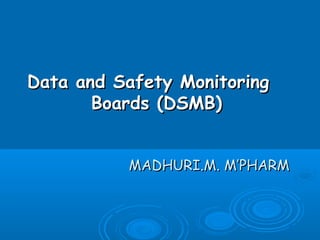
Data and safety monitoring boards
- 1. Data and Safety Monitoring Boards (DSMB) MADHURI.M. M’PHARM
- 2. What is a D(ata)S(afety)M(onitoring)B(oard)? A committee charged with monitoring safety efficacy progress of a clinical trial Aka DMC, DSMC, IDMC, …
- 3. History Data and Safety Monitoring 1979 Every clinical trial should have provision for data and safety monitoring The size of the monitoring committee depends upon the nature, size, and complexity of the clinical trial The Principal Investigator was expected to perform the monitoring function but may have had others to help
- 4. 1994 It was recommended that every clinical trial, even those that pose little likelihood of harm have an external monitoring body 1998 Establishment of Data Safety Monitoring Board (DSMB) is required for multi-site clinical trials involving interventions that entail potential risk to the participants
- 5. 2006 FDA guidance : Establishment and Operation of Clinical Trial Data Monitoring Committees
- 6. Composition Voting •Physician(s) in specialty area (disease, side effects) •Epidemiologist/trial methodologist •Statistician •Clinical pharmacologist/safety specialist? •Ethicist, patient representative, lawyer? •Need effective chairman
- 7. Non-Voting •Study or steering committee chair •Sponsor representatives •Reporting statistician
- 8. Voting members 3-10 experts in disease, study drug, clinical trials Multidisciplinary, independent Disinterested – no conflict of interest Experience on other DSMBs Chair & statistician Some inexperienced to train them Must take responsibilities seriously
- 9. Qualifications 1. Expertise in the field 2. Experience in conduct of CT & statistical knowledge 3. Independence from direct management of CT 4. No conflict of interest
- 10. Rationale for using DSMBs in research Ethical compact protecting trial participants Sponsor: regulatory responsibilities May alsoadvise about changes in protocol, procedures NIH often uses DSMB in an advisory capacity – different from industry-sponsored trials
- 11. Trials that need a DSMB Double-blind Large (hundreds, thousands of subjects) Multi-center/multi-national Long duration Endpoint: death or stroke or …
- 12. Participants have high intrinsic mortality risk HIV infection, cancer Sepsis, pulmonary disease, cardiac failure Trial studying a new chemical entity Recommended (strongly) by regulatory agency
- 13. Trials that DON’T need a DSMB Phase I studies, pilot studies (some) Studies of symptom relief Studies with other very close safety monitoring Timeline so short the DSMB can’t operate
- 14. Requirements for DSMB’s NIH FDA Typically require DSMB Risk to trial participants • Protocols that generate • Study endpoint blinded/randomized data • Large trials of long- • Multicenter protocols; duration > minimal risk Practicality • Gene transfer protocols • Short trials May require DSMB Assurance of scientific validity • Protocols requiring • Inclusion of new scientific special scrutiny knowledge without adding High public interest bias Vulnerable populations
- 15. Purpose of DSMB • Identify high rates of ineligibility determined after randomization • Identify protocol violations that suggest clarification of changes to protocol are needed • Identify unexpectedly high drop out rates that threaten the trial’s ability to produce credible results • Ensure validity of study results
- 16. Duties of DSMB Review the research protocol and plans for data and safety monitoring Evaluate the progress of the trial with periodic assessments of data quality and timeliness, participant recruitment, participant risks and benefits; Reports from related studies
- 17. Make recommendations to the IRB and investigators concerning continuation or conclusion of the trial Review the adverse event reports.
- 18. Timing of meetings Meets annually Periodically when Risk to subjects is high Vulnerable subjects Large volume of data to review
- 19. Meetings (Brief executive session) Open session Closed session Executive session Disseminate recommendations Open session Directly to sponsor representative
- 20. Initially an open session is conducted • members of the clinical trial may be present • may focus on accrual, protocol compliance, and general toxicity issues • no outcome results discussed during this session
- 21. Followed by a closed session • DSMB members only • outcome results discussed • statistical reports (if necessary) Finally an executive session • DSMB members only • discuss the general conduct of the trial • all outcomes (including toxicities and AE) • develop recommendations and vote if necessary
- 22. Contents and intent of report Purpose –allow DSMB to make informed decisions 1. Summary of protocol and outstanding issues 2. Recruitment and follow-up 3. Baseline data 4. Check of randomization 5. Timeliness of data & adjudication of endpoints 6. Adverse events with study-specific coding 7. Dosage of study medication 8. Vital signs and laboratory parameters 9. Outcome data
- 23. Recommendations from the DSMB Shared with Sponsor, Steering Committee, IRBs Must prevent unblinding of study team Be careful with communications! During the trial, everyone reads tea leaves DSMB must keep impeccable records What did they know and when did they know it? Did they change their behavior and rules in response to data?
- 24. Are There Disadvantages to Having a DSMB? * YES! Increases complexity of trial management Increases costs If the ethical imperatives discussed earlier are not applicable, other (simpler) monitoring approaches are usually acceptable
- 25. Dechallange & Rechallange Dechallenge -The clinical decision to withdraw drug treatment after a possible ADR occurred Considered to be - +ve : if the reaction occurs at each dose & abates completely or partially after withdrawal of drug -ve : if the reaction does not abate after withdrawal of drug Not applicable where : * Drug is one dose treatment (vaccine ) * Reactions occurred after the drug was discontinued * congenital anomaly (irreversible )
- 26. Rechallenge- Reintroduction of the same drug which had been withdrawn due to ADR following +ve dechallenge Considered to be +ve : reoccurrance of similar signs & symptoms as that of previous -ve : failure of appearance of similar signs & symptoms as that of previous one Not applicable where * same as that of rechallenge for ethical reasons rechallenge is rarely performed but it may eb carried out when the results are in the interest of patient suffering the reaction, particularly when there are no suitable alternative drugs
